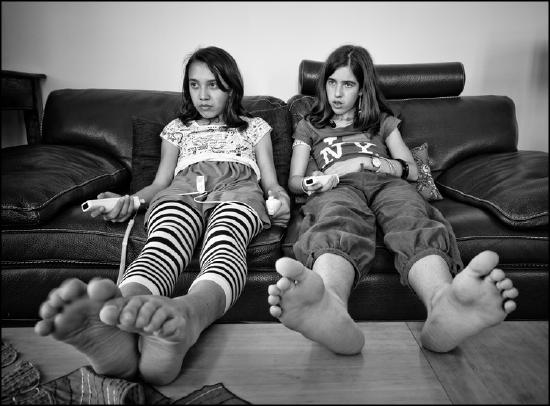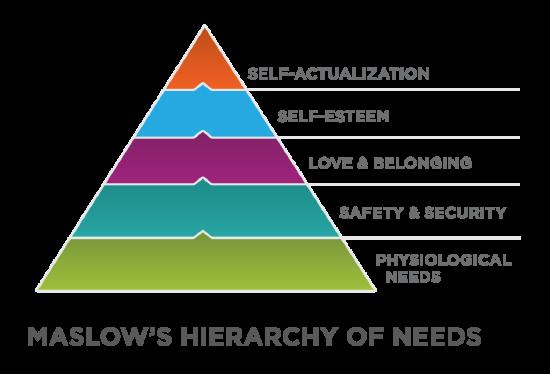2.4: Psychology
- Page ID
- 84069
Psychological Factors
Consumer Decisions and the Workings of the Psyche
When we talk about psychological factors that influence consumer decisions, we are referring to the workings of the mind or psyche: motivation, learning and socialization, attitudes and beliefs.
Motivation

A motive is the inner drive or pressure to take action to satisfy a need. A highly motivated person is a very goal-oriented individual. Whether goals are positive or negative, some individuals tend to have a high level of goal orientation, while others tend to have a lower level of goal orientation. People may display different levels of motivation in different aspects of their lives. For example, a high school junior may be flunking trigonometry (low motivation) while achieving champion performance levels at the video game Guitar Hero (high motivation).
In order for any consumer purchasing decision to happen, the need must be aroused to a high enough level that it serves as a motive. At any given time, a person has a variety of needs that are not of sufficient urgency to generate the motivation to act, while there are others for which he is highly motivated to act. The forces that create a sense of urgency and motivation may be internal (people get hungry), environmental (you see an ad for a Big Mac), or psychological (thinking about food makes you hungry).
For motivation to be useful in marketing practice, it is helpful for marketing managers to understand how motivation plays into a specific purchasing situation—what triggers consumers to set goals, take action, and solve their need-based problems.
Motivation starts with an unmet need, as does all consumer problem solving. One of the best-known theories about individual motivation is the work of A. H. Maslow, known as the hierarchy of needs. Maslow developed a model that lays out five different levels of human needs. These needs relate to one another other in a “need hierarchy,” with basic survival-oriented needs at the lower levels of the hierarchy, building up to higher emotional needs associated with love, self-esteem, and self-fulfillment. This hierarchy is shown in the figure below:

Physiological needs are at the first level of Maslow’s hierarchy: hunger, thirst, and other basic drives. All living beings, regardless of their level of maturity, possess physiological needs. Physiological needs are omnipresent and recur throughout nature.
Safety and security are second in Maslow’s hierarchy. Safety and security needs imply a continued fulfillment of physiological needs, as well as the absence of the threat of physical harm. Safety and security encompass both physical and financial security, because financial security is linked to a person’s ability to have her physiological needs met. Health and physical well-being and protection from accidents are also associated with this level of need. This is considered an extension of the more basic needs.
Love and belonging are third in Maslow’s hierarchy of needs. Love encompasses the needs for belonging, friendship, human intimacy, and family. They involve a person’s interaction with others and the need to feel accepted by social groups, large or small.
Self-esteem is the fourth level. Self-esteem includes the need to feel good about oneself, to be respected and valued by others, and to have a positive self-image.
Self-actualization is the fifth and highest level in Maslow’s needs hierarchy. Also described as “self-fulfillment,” this is the need humans feel to reach their full potential and to accomplish all that they can with their talents and abilities. Different people may express this need in very different ways: for one person, self-actualization might involve musical or artistic pursuits, for another, it’s parenting, and for a third the focus might be athletics. At different points in their lives, individuals may express this need through different pursuits.
In his work, Maslow asserts that these five levels of needs operate on an unconscious level. In other words, people may not even be aware that they are concentrating on one particular level of need or an assortment of needs. Maslow’s theory suggests that lower levels of need must be met before an individual can focus on higher-level needs. At the same time, a person may experience several different needs simultaneously. How an individual is motivated to act depends on the importance of each need.
When we think about Maslow’s needs hierarchy in the context of marketing and segmentation, we might use the hierarchy to help identify a common level of needs for a given segment. Effective and powerful marketing may operate at any level of Maslow’s hierarchy. Consider the following examples:
- In-N-Out Burger’s freeway billboards featuring a giant, 3-D cheeseburger (physiological needs)
- Procter & Gamble’s “Thank You Mom” ad campaign featuring dedicated parents of Olympic athletes and their loving relationships (love & belonging)
- The U.S. Army’s famous “Be All You Can Be” slogan and advertising campaigns encouraging young adults to join the army (self-actualization), shown in the following video.
- Holland, Stephanie. “Marketing to Women Quick Facts.” She-Conomy, 15 Sept. 2016, http://she-conomy.com/report/marketing-to-women-quick-facts. ↵
- https://journalofinternationalmanagement.wordpress.com/2011/05/16/walmarts-downfall-in-germany-a-case-study/ ↵
- www.foxbusiness.com/industries/2015/10/12/why-procter-gamble-mcdonalds-ford-are-chasing-black-consumer/, http://targetmarketnews.com/storyid06071201.htm ↵
- Revision and Adaptation. Authored by: Lumen Learning. License: CC BY: Attribution
- Introduction to Factors Influencing Consumer Decisions. Provided by: Lumen Learning. License: CC BY: Attribution
- Putting Consumer Attitudes and Beliefs to the Test. Provided by: Lumen Learning. License: CC BY: Attribution
- Chapter 4: Understanding Buyer Behavior, from Introducing Marketing. Authored by: John Burnett. Provided by: Global Text. Located at: http://solr.bccampus.ca:8001/bcc/file/ddbe3343-9796-4801-a0cb-7af7b02e3191/1/Core%20Concepts%20of%20Marketing.pdf. License: CC BY: Attribution
- GALAXY S (I9000). Authored by: Cheon Fong Liew. Located at: https://www.flickr.com/photos/liewcf/4764970338/. License: CC BY-SA: Attribution-ShareAlike
- Diamond Ring. Authored by: Jeffrey Beall. Located at: https://www.flickr.com/photos/denverjeffrey/8476801743/. License: CC BY-SA: Attribution-ShareAlike
- Too Much Lego. Authored by: Michael Anthony Dziedzic. Located at: www.flickr.com/photos/129866963@N06/24149788356/. License: CC BY-ND: Attribution-NoDerivatives
- Martha Stewart's Cakes. Authored by: Sylvia Chan. Located at: https://www.flickr.com/photos/abakedcreation/10122941096/. License: CC BY-NC-ND: Attribution-NonCommercial-NoDerivatives
- Wine Tasting. Provided by: Pixabay. Located at: pixabay.com/en/wine-drink-wine-glass-red-wine-335672/. License: CC0: No Rights Reserved
- Couch Potatoes. Authored by: mitch huang. Located at: https://www.flickr.com/photos/mitch98000/3498386012/. License: CC BY: Attribution
- Heinz and Packaging. Provided by: BBC. Located at: https://youtu.be/pp-6vJdYL80. License: CC BY-NC-ND: Attribution-NonCommercial-NoDerivatives
- A belated bouquet for YOU!. Authored by: Cheryl. Located at: https://www.flickr.com/photos/eraphernalia_vintage/4596842255/. License: CC BY-SA: Attribution-ShareAlike
- Jeff Phillips SK8 Party. Authored by: Scott Lumley. Located at: https://www.flickr.com/photos/scottlumley/10692510614/. License: CC BY: Attribution
- Shopping Family. Authored by: Tim Riley. Located at: https://www.flickr.com/photos/timriley/403254675/. License: CC BY-NC-ND: Attribution-NonCommercial-NoDerivatives
- Alma de Mexico dancers at Latino Fest today in Lorain. Authored by: Rona Proudfoot. Located at: https://www.flickr.com/photos/ronnie44052/3938931572/. License: CC BY-SA: Attribution-ShareAlike
- Demise of the Mall and Reinvention. Provided by: BBC. Located at: https://youtu.be/F_pHmmVov34. License: CC BY-NC-ND: Attribution-NonCommercial-NoDerivatives
- Be All That You Can Be In The Army commercial 1982. Authored by: Kevin Noonan. Located at: https://youtu.be/VlPEg9LCKgo. License: All Rights Reserved. License Terms: Standard YouTube License

